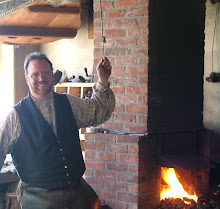 Soft Coal. Bituminous Coal. Coke. This is the fuel of the Blacksmith shop.
Soft Coal. Bituminous Coal. Coke. This is the fuel of the Blacksmith shop. Our shop has two large stone forges with wood and leather bellows. When originally constructed the shop probably used hardwood charcoal as fuel because it was available locally and coal was not. Since charcoal can’t be stored outside through the winter without degrading there is a stone and brick fuel vault build onto the back of the shop. That allowed charcoal to be stored without fear of fire or decay.

 By the 1840s mineral coal from Pennsylvania was available by way of the Erie Canal. That is the fuel we still use today. The forges consume more than a ton of coal each year. Each fall we refill the coal bin with another year’s supply. Coal is dumped in a pile outside of the shop. We then move several tons into the shop each fall. I will haul the coal in one wheelbarrow-full at a time. It takes about 50 wheelbarrow loads to fill it for another year. The work is worth it, as there is a sense of security in seeing a full coal bin!
By the 1840s mineral coal from Pennsylvania was available by way of the Erie Canal. That is the fuel we still use today. The forges consume more than a ton of coal each year. Each fall we refill the coal bin with another year’s supply. Coal is dumped in a pile outside of the shop. We then move several tons into the shop each fall. I will haul the coal in one wheelbarrow-full at a time. It takes about 50 wheelbarrow loads to fill it for another year. The work is worth it, as there is a sense of security in seeing a full coal bin!The Peleg Field Blacksmith Shop is 182 years old, and has been in service at least 170 of those years. This may be the 171st time fuel has been hauled into the bin by labor and the sweat of the brow. By continuing these traditions of shoveling coal, lighting the daily fire, and working at the forge I am continuing the work of the generations of Blacksmiths in the shop before me.

I have been looking for basic information on coal specifically for use in a forge for quite some time, and now I have finally come to the right place. Your story of tradition came as a welcome and inspiring find in addition to necessary information. Thank you.
ReplyDeleteThank you for your web site. I am new to blacksmithing and your info on coal was a big help. R/ Joe Hagerman
ReplyDeleteCoal is one of the key industries in India. The country has a number of coal mines. Basic Types of Indian coal (from North East, INDIA) are: Coal Suppliers
ReplyDelete